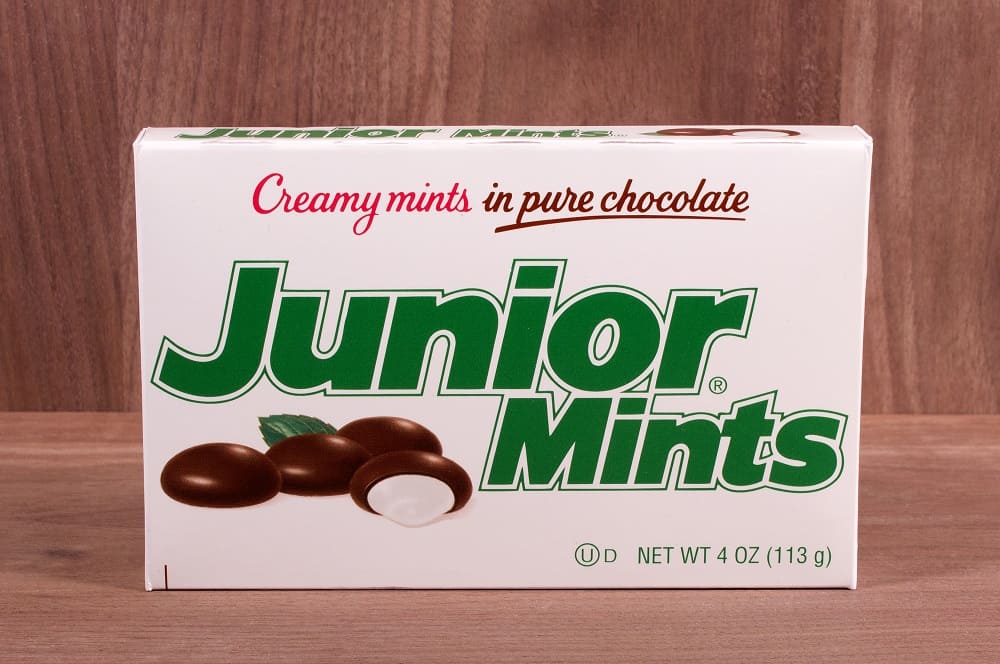Junior Mints are popular candy snacks characterized as being small round pieces of dark chocolate with mint filling inside. The company that produces Junior Mints is Tootsie Roll Industries, the same company that also produces Tootsie Rolls and Tootsie Pops. First introduced back in 1949, it is estimated that 15 million Junior Mints are being produced every single day (1).
When looking at candies and other related food products, it is difficult to find one that does not contain any problematic ingredient – a sentiment that falls on Junior Mints as well. Unfortunately, the chocolate mint candy contains confectioner’s glaze, an ingredient that directly utilizes an animal-derived substance. Thus, Junior Mints cannot be considered vegan. Furthermore, Junior Mints are also vulnerable to cross-contamination during the manufacturing process which means they could possibly contain traces of egg and milk in them.
Table of Contents
Are Junior Mints Vegan?

Unfortunately, Junior Mints are not vegan since they contain animal products. Specifically, the chocolate mint candy snack contains confectioner’s glaze, a common ingredient added to candies, sweets, and pastries to give them a nicer appearance. Unfortunately, confectioner’s glaze contains an animal product called shellac. Thus, Junior Mints cannot be considered vegan.
Additionally, Junior Mints also contains sugar which is a common ingredient that typically divides the vegan community. Although sugar is conventionally a plant-derived product, its manufacturing process can make sugar non-vegan. This little piece of information is difficult to trace which makes it difficult to determine whether sugar and products containing sugar are vegan or not.
Lastly, Junior Mints are prone to cross-contamination as their packaging includes the label: “Eggs and milk may be present.” Even though the ingredients list of the original Junior Mints does not contain eggs and milk, the equipment used to make the original Junior Mints might be the same equipment used to make other products that include those ingredients which is why it is possible to detect trace amounts of egg and milk in Junior Mints.
While there are only four varieties of Junior Mints available, the other varieties also have some ingredients that vegans should be aware of such as natural products and dairy products.
Junior Mints Ingredients List
The list of ingredients of the original Junior Mints includes (2): sugar, semi-sweet chocolate (sugar, chocolate processed with alkali, cocoa butter, soy lecithin - an emulsifier, vanillin - an artificial flavor), corn syrup, confectioner’s glaze, food starch - modified, peppermint oil, invertase (an enzyme). Egg and milk may be present. Contains soy. Contains a bioengineered food ingredient made from U.S. crops.
Junior Mints also come in different varieties which could contain different ingredients as well (3). These varieties include Junior Mints Minis, Junior Caramels, and Junior Mints Deluxe.
Dairy Products
Dairy products are food products made from mammalian milk, typically from cows. These can include cheese, butter, yogurts, and the like. Although dairy products contain a wide variety of nutrients such as vitamins and calcium, vegans usually avoid milk and food products because they are animal-derived.
Many vegans find milk and dairy products to be especially unethical due to how the milk industry treats cows. Cows are usually intentionally impregnated to make their bodies begin to produce milk. The offspring are even separated from the mother to maximize milk collection.
The varieties of Junior Mints that intentionally include dairy products are Junior Caramels and Junior Mints Deluxe. Junior Caramels contain milk in milk chocolate as well as dry whole milk. On the other hand, Junior Mints Deluxe contains milk.
Sugar
Sugar, also known as sucrose, is a common sweetener used in the food industry. Sugar is conventionally derived from plant sources such as sugarcane and sugar beets. Despite it being derived from plants, sugar is a controversial ingredient in the vegan community as the ingredient can potentially be non-vegan depending on how it is produced.
To make the sugar more appealing, sugar companies often further refine their sugar through refinement processes. One such refinement process is filtration. Different companies use different filtration methods, but some companies filter sugar through bone char – the charred skeletal remains of different animals. Thus, sugar that has been filtered with bone char can no longer be considered vegan since its production involves an animal product.
A problem with sugar is that it is difficult to determine if whether it has been produced with bone char. It might be easier to determine for sugar itself, but it is a whole different case for sugar used in food products. Food companies can possibly source ingredients such as sugar from multiple sources which means it would be difficult to track if whether the sugar used in their products is vegan or not.
The varieties of Junior Mints that contain sugar include the original Junior Mints, Junior Mints Minis, Junior Caramels, and Junior Mints Deluxe.
Confectioner’s Glaze
Confectioner’s glaze is an alcohol-based solution that gives food and confectionery a smooth and shiny glaze. The same substance can also be used in other industries. For example, it is called pharmaceutical glaze when it is used for medicine.
Unfortunately, this ingredient is completely non-vegan as it contains shellac, a resin that is acquired from female lac beetles (Kerria lacca). The insects use this resin in preparation for their soon-to-hatch eggs. Due to the nature of this substance, products that have shellac or confectioner’s glaze can no longer be considered vegan since it involves an animal product.
Only one variety of Junior Mints contain confectioner’s glaze: Junior Caramels.
Natural Flavors
A common ingredient that can be found in many food products is natural flavors. Defined by the FDA, natural flavors is an umbrella term for natural substances that serve as flavoring agents. This is also a way for food companies to keep some proprietary information for how they flavor their products. However, the problem arises due to the definition of natural flavors. Specifically, the FDA defines natural flavors as (4):
“The essential oil, oleoresin, essence or extractive, protein hydrolysate, distillate, or any product of roasting, heating or enzymolysis, which contains the flavoring constituents derived from a spice, fruit or fruit juice, vegetable or vegetable juice, edible yeast, herb, bark, bud, root, leaf or similar plant material, meat, seafood, poultry, eggs, dairy products, or fermentation products thereof, whose significant function in food is flavoring rather than nutritional.”
FDA.gov
Reading the definition the FDA provides, natural flavors encompass both animal- and plant-derived sources. This means that if a food product predominantly contains vegan ingredients and also natural flavors as well, then there is still some room for the possibility that that food product is non-vegan. In this regard, natural flavors are considered a gray area ingredient.
Cross-Contamination
Even when food products are completely made with vegan ingredients, trace amounts of non-vegan substances can possibly end up in those food products due to cross-contamination. Cross-contamination is when the same equipment is used to prepare vegan food products and non-vegan food products.
Food companies are often required to label food products that are prone to cross-contamination with specific possible contaminants as an allergen warning. For example, people that are allergic to nuts can then be warned that even if a food product does not have nuts, there is still a very small chance of an allergic response.
Junior Mints have a cross-contamination warning. Specifically, the packaging of the original Junior Mints contains the label “egg and milk may be present.” Although those ingredients are not intentionally included in the original Junior Mints, those are possible cross-contaminants.
References




